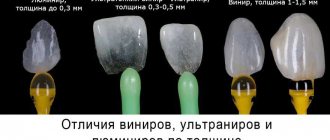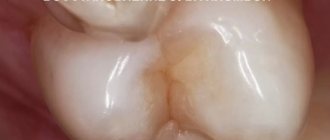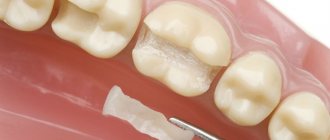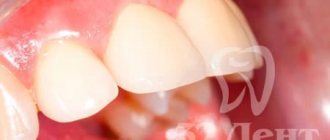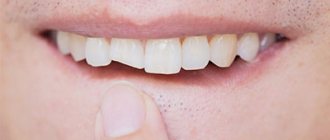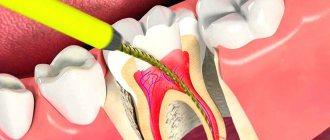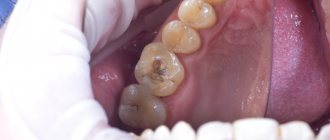In the meantime, it is important to compensate for even partial tooth loss, and not only for the sake of aesthetics: when chewing teeth are destroyed, the function of mechanical processing of food is also seriously impaired. In turn, this affects the health of the entire digestive system.
The two main methods of restoring teeth are fillings and crowns. How a crown differs from a filling is probably known even to those who have nothing to do with dentistry. A crown is a kind of cap made of durable material. It covers the entire damaged tooth, while a filling only fills a defect in the body of the tooth, completing it to its natural shape. Of course, if the defect is small, there is no point in installing a crown - a small carious cavity can be reliably closed with a filling. But what to choose if the tooth is 50–60% destroyed?
When is a filling needed?
If less than a third of the tooth is damaged, then in most cases the doctor restores it using filling materials. Modern photopolymer fillings
allow you to recreate the shape and color of a natural crown, add aesthetics to the surface, and adjust the position of the unit.
But in case of serious damage, a large filling is often (!) placed in the cavity, which will not withstand long-term significant loads. If a tooth has been depulped, then over time its walls become fragile and further destruction occurs. When the carious cavity is large, restoring the destroyed tooth crown with a regular filling is acceptable, but does not guarantee long-term preservation.
Differences
Typically, crowns are much stronger than fillings. The only exceptions are structures made of plastic.
If the filling material falls out, the tooth will require repeated treatment, which cannot be said in the case of an installed crown, which can be reinstalled at any time in the absence of external damage.
Fixing crowns takes much longer than the filling process.
Crowns allow you to ideally restore the lost shape of a tooth, while using a filling it is not always possible to achieve this result.
What is a tab
Veneers are used to restore the beauty of the front teeth and strengthen them.
Stump tab
used to strengthen molars. More often it is a mini-prosthesis that completely repeats the shape of the internal destroyed part of the crown. It is inserted into the tooth and secured with a special dental compound.
Such structures are a good way to restore a tooth. The inlay is used when the destruction of the natural crown exceeds 30% and there is a healthy root.
Their service life is 20 years or more, the materials tolerate chewing loads and correspond to the anatomical structure of the tooth. Their shade remains unchanged under the influence of food coloring. There are options:
- Restorative
, their role is close to the function of a filling. They are attached to the top of the unit without touching the channels. - Stump mini-prostheses
. Such a frame is fixed in the channel. Then the tooth is covered with a crown. A post-core inlay can help if the visible part of the tooth has crumbled and only the root remains.
Metal-free tab
– restoration of the dental crown, which is orthopedically justified and aesthetically pleasing. The surface wears out synchronously with the enamel, without any discomfort.
When salvation is a crown
A dental inlay is a way to save a tooth when it is not possible to fill it. If the damage is significant, then a filling or inlay will not help; more reliable protection will be required - a crown
.
Modern designs are durable and help maintain quality of life when 50% or more
of tooth tissue is lost.
Restoring a tooth with a crown (the price is calculated depending on the chosen material) is reliable protection against recurrent caries. Microparticles of food do not get under the crown, pathogenic microflora do not penetrate, and there is no violation of the marginal seal.
Ceramic, metal-ceramic or zirconium crowns on a tooth will become a reliable covering for the thinned, fragile walls of a natural tooth and will protect them from chipping or breaking.
Modern dentistry makes it possible to bring the shade of the crown as close as possible to the natural shade of the enamel, so the presence of the structure is almost invisible. Installing crowns on chewing teeth is an opportunity not to limit your diet, to eat familiar foods without fear of destruction of the teeth.
Crown or filling: what to choose?
Timing and method of fixation
The entire filling process is carried out in the oral cavity and takes from 15 minutes to an hour.
The filling material is applied directly to the affected tooth. When chewing food, the upper and lower jaws close and put pressure on the filling. It transfers the pressure further – to the tooth itself. If the area of the remaining dental walls is larger than the volume of the filling (preferably several times), there is no danger. If the remaining part is small, the pressure may be excessive and the tooth will eventually break. The crown is placed on top of the tooth and puts pressure on the root, not on the walls. It is impossible to establish it in one visit to the doctor. The design is made in a laboratory after several fittings and impressions are taken. On average, the process takes 7 days.
Risks
Installing a crown requires extensive preparation work. The service life of the prosthesis and the safety of the tooth underneath depend on how well they are performed. Root canals that are not completely filled will lead to the development of an inflammatory process under the crown. First there will be slight discomfort, then pain, and if measures are not taken in time, you may even lose your tooth.
Poor quality treatment of tissues before filling is also fraught with troubles, for example, the filling falling out. But putting it in place is easier than treating a prosthetic tooth. After all, you will have to remove the crown, remove old fillings, treat with antibiotics, fill again, and only then proceed to re-prosthetics.
Therapeutic filling copes well with minor damage to the tooth surface
Another important point. All filling materials are subject to abrasion. If we are talking about a small area, there is nothing to worry about. If most of the chewing surface is sealed, we will encounter the Godon-Popov effect - dentoalveolar elongation. Its essence is that antagonist teeth (teeth of the lower and upper jaws that touch when chewing) influence each other. And the deformation of one leads to the deformation and displacement of the other.
When the surface of a filled dental unit is worn away, its contact with the antagonist weakens and it begins to shift towards deformation - to move forward. Time passes, the doctor and the patient decide to install a crown instead of a filling, but it turns out that there is no room for it. It is necessary to violate the integrity of the tissues of the antagonist tooth by grinding the protruding part.
Aesthetics
If the tooth is damaged by 5-30%, and the carious cavity is located on its inner or side walls, the filling will not be visible after installation. The dentist will select a material of the same tone as the natural tooth and polish it, hiding the junction of the walls and the filling material.
If 50 percent or more of the surface is damaged, it will not be possible to disguise the seam. The filling will stand out against the background of the real tooth and over time these differences will become more noticeable.
With a crown, such questions do not arise.
A properly selected and installed crown is no different from a real tooth.
Price
Filling not only takes less time, but also costs less than a crown. Treatment of initial caries at Visit Stoma costs 2,000 rubles, installation of a metal-ceramic crown costs 7,000. But there are a few “buts”.
The average filling becomes unusable after 5 years, and a correctly installed crown, at least after 25. But after going through the filling several times, you will most likely come to the need to protect the tooth with a crown. About 8-10 years from now.
Restoring teeth using root veneers
In orthopedics, there are unique possibilities for restoring teeth in cases where only one root remains of a tooth. You must immediately understand that the root tissue of the teeth must be healthy - this is the main condition for 100% tooth restoration. Look at the photo to see what we are talking about - caries-affected tissues are removed and ground down to healthy tooth tissues:
In such cases, veneers with the root part
:
And this is how beautifully, and most importantly, you can reliably restore your teeth:
Patients who encounter such technologies for the first time experience a wow effect, and their smile is not only restored, but becomes incredibly beautiful:
By the way, this clinical example can be viewed in more detail HERE
Tooth restoration with a crown using metal-ceramics
An inexpensive solution is a one-piece tooth crown. It is durable and justified for molar prosthetics. The durable frame is covered with layers of ceramics. This design is aesthetic and convenient.
Tooth restoration with a metal-ceramic crown is a budget-friendly and reliable way to maintain the health of your teeth. The cost of a crown is 17,900 rubles per tooth. An impression is made that follows the contours of the natural crown, recording the characteristics of the bite, and a frame is created according to the obtained parameters. Each applied layer of porcelain coating is baked under high temperature.
If there is no healthy root, the tooth has long been removed, there are problems with the structure of soft and bone tissues, then the only way to return to your normal lifestyle and maintain health is implantation. Today there are methods for restoring a tooth crown, completely replacing a lost unit - in my clinic the cost of metal-free options is from 27,900 rubles
for a destroyed restored tooth (and
from 34,900 rubles
for a crown for an implant).
I, Dr. Samsakov, will produce ceramic tooth modules of any complexity, post-core and other types of inlays, “crown plus tooth root” modules using CEREC technology - cost from 27,900 rubles. per tooth The process will take about 1.5 hours.
What is the difference between an inlay and a crown?
It is clear that if you have a small hole, then you do not need to install a crown. But if the destruction is more than 30-50%, then this is a reason to think about it.
Since an inlay is better than a filling (you learned this above), let’s look at its advantages over a crown. What is an inlay for dental prosthetics? In this case, it represents a durable orthopedic structure.
Important! An inlay is an excellent solution for chewing molars. But on severely damaged front ones it is worth putting a crown.
